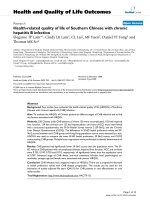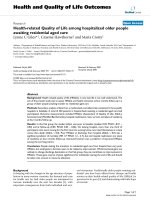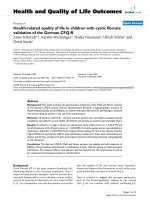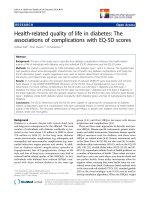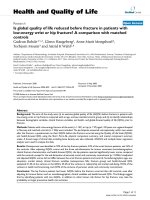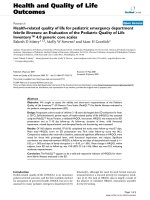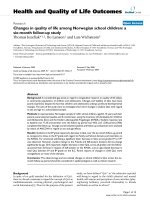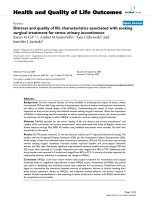báo cáo hóa học: " Distress and quality of life characteristics associated with seeking surgical treatment for stress urinary incontinence" pptx
Bạn đang xem bản rút gọn của tài liệu. Xem và tải ngay bản đầy đủ của tài liệu tại đây (279.79 KB, 8 trang )
BioMed Central
Page 1 of 8
(page number not for citation purposes)
Health and Quality of Life Outcomes
Open Access
Review
Distress and quality of life characteristics associated with seeking
surgical treatment for stress urinary incontinence
Karen M Gil*
1,2
, Amber M Somerville
2
, Sara Cichowski
1
and
Jennifer L Savitski
1
Address:
1
Department of Obstetrics and Gynecology, Akron General Medical Center, Akron, OH, USA and
2
Northeastern Ohio Universities
College of Medicine and Pharmacy, Rootstown, OH, USA
Email: Karen M Gil* - ; Amber M Somerville - ; Sara Cichowski - ;
Jennifer L Savitski -
* Corresponding author
Abstract
Background: Current research focuses on three variables in evaluating the impact of stress urinary
incontinence (SUI) on daily living: severity of incontinence, distress or bother resulting from incontinence,
and effect on health related quality of life (HRQoL). Understanding the impact of these variables is
important as they are the driving force behind women seeking surgical treatment. Given the importance
of HRQoL in determining need for treatment, as well as evaluating treatment success, this review provides
an assessment of the degree to which HRQoL is impaired in women seeking surgical treatment.
Methods: PubMed searches for the terms "quality of life and distress and urinary incontinence" and
"quality of life and bother and urinary incontinence" were performed with limits of English, human and
female subjects through May 2008. All studies using validated instruments were included. No time limit
was placed on the search.
Results: Of 178 articles retrieved, 21 met the inclusion criteria, and 17 reported methods of scoring. The
studies used the Urogenital Distress Inventory (UDI) and the Incontinence Impact Questionnaire (IIQ).
Wide ranges of mean and individual levels of severity of symptoms, UDI and IIQ scores were seen among
women seeking surgical treatment. Fourteen studies reported baseline and post-surgical treatment
distress and QoL data. Statistically significant improvements between baseline and post-surgical UDI and
IIQ scores were reported in 12 studies. Reported cure rates ranged from 46% to 97%. Satisfaction with
the procedure was reported in 4 studies and ranged from 84% to 91%. A minority of studies reported the
relationship between reduction in symptoms and change in HRQoL.
Conclusion: HRQoL is the main reason women seek surgical treatment for incontinence and surgical
treatment leads to a significant improvement in mean HRQoL scores. Assessment of HRQoL has proved
less useful in identifying why individual women seek treatment for incontinence. Preliminary work has
begun to characterize the interaction between severity of symptoms, distress or bother resulting from
these urinary symptoms, impact on HRQoL, and treatment seeking behavior, but further research is
needed. Greater standardization in the reporting of results of distress or bother and HRQoL would allow
for comparison across studies.
Published: 5 February 2009
Health and Quality of Life Outcomes 2009, 7:8 doi:10.1186/1477-7525-7-8
Received: 24 September 2008
Accepted: 5 February 2009
This article is available from: />© 2009 Gil et al; licensee BioMed Central Ltd.
This is an Open Access article distributed under the terms of the Creative Commons Attribution License ( />),
which permits unrestricted use, distribution, and reproduction in any medium, provided the original work is properly cited.
Health and Quality of Life Outcomes 2009, 7:8 />Page 2 of 8
(page number not for citation purposes)
Urinary incontinence (UI) is defined by the International
Continence Society as the "complaint of any involuntary
leakage of urine" [1]. Urinary incontinence is associated
with significant reductions in health related quality of life
(HRQoL) [2-8]. Prevalence estimates of UI among com-
munity dwelling women range from 10 to 40%, while
estimates for institutionalized women are greater than
50% [9]. The wide range in estimates stem, in part, from
differences in definitions of UI and characteristics of the
population studied [10].
Stress UI (SUI) is an involuntary leakage of urine with
effort or exertion, sneezing or coughing [1]. Among
incontinent women, estimates are that 50% suffer from
SUI [11]. Treatment for SUI is primarily surgical and is
largely patient driven. There are a variety of measures of
severity of UI, but none has emerged as the gold standard
[12]. In the absence of a clear-cut standard for providing
incontinence surgery that is based on severity, indication
for treatment is based on the extent a woman's HRQoL is
affected. HRQoL is traditionally a concept that has been
used to "assess the patient's overall sense of well-being
and how it relates to the disease and the disease treat-
ment" [13]. Patient reported outcomes (PRO) are often
viewed as a secondary endpoints in order to measure
symptom control and treatment toxicities in conditions
such as gynecologic cancer [14] where the primary out-
come is generally survival. In comparison, PRO may be
the primary end point in seeking treatment for SUI and
the primary end point in assessing treatment effectiveness.
Recent studies have examined the role of distress or
bother in assessing the impact of UI on HRQoL in com-
munity dwelling women, in part to begin to determine
what factors affect treatment seeking behavior [2-6]. In
general, these studies found that women who experienced
greater symptom bother or distress reported a greater
impact on HRQoL, however the majority do not seek
treatment [2,4-6]. It is not known what factors ultimately
lead some women to seek treatment for UI and then
undergo surgery. A recent pan-European study of 9487
women who had sought treatment for UI found that
severity of symptoms was the most important predictor of
QoL and bother [8]. Assessment of severity of symptoms,
degree of distress or bother, and impact on QoL has not
been systematically investigated in women who have
elected to undergo surgery. A review of these variables will
provide a framework for further investigating why some
women elect not to seek treatment, and will provide an
informational base to assess treatment success using PRO.
This study investigates the level of distress or bother, and
impact on QoL, resulting from SUI in women who have
elected to undergo surgery.
Methods
Two searches were conducted using the PubMed version
of Medline. The first search used the terms "quality of life
and distress and urinary incontinence" and the second
used the terms "quality of life and bother and urinary
incontinence." The searches were limited to studies pub-
lished in English conducted on human, female subjects.
The search was conducted through May 2008 and no time
limit was placed on the search. Validation or testing of
outcome measures and prevalence studies were not
included. Articles were excluded if subjects were not
incontinent, if women were receiving treatment for a
medically necessary condition such as bladder cancer or if
data from women with SUI were not presented separately
from women with other forms of UI.
All articles using validated instruments, in their entirety
(not just a few questions) that reported scores for the
whole instrument were included. All validated instru-
ments were included. The Symptom and Quality of Life
Committee of the International Consultation on Inconti-
nence performed a systematic review of questionnaires
related to urinary and anal incontinence between 2001
and 2004 [15]. They identified 23 robust and relevant
questionnaires, including 14 Grade A questionnaires rele-
vant to the assessment of urinary incontinence in women.
Instruments that combined symptoms and QoL impact
were the International Consultation on Incontinence
Questionnaire (ICIQ) [16], the Bristol Female Lower Uri-
nary Tract Symptoms Questionnaire-Short Form
(BFLUTS-SF) [17], and the Stress and Urge Incontinence
and Quality of Life Questionnaire (SUIQQ) [18]. Instru-
ments that addressed urinary incontinence symptoms
were the Urogenital Distress Inventory (UDI) [19] and the
UDI-6 [20], the Incontinence Severity Index (ISS) [21]
and the BFLUTS [22]. Instruments that examined QoL
impact of urinary incontinence were the Incontinence
QoL questionnaire (I-QoL) [23]), The Stress-related leak,
Emptying ability, Anatomy, Protection, Inhibition, Qual-
ity of life, Mobility and Mental status Incontinence Classi-
fication System (SEAPI-QMM) [24], the King's Health
Questionnaire (KHQ) [25], the Incontinence Impact
Questionnaire (IIQ) [19], the IIQ-7 [20], the Urinary
Incontinence Severity Score (UISS) [26] and the CONTIL-
IFE: a Quality of Life questionnaire for urinary inconti-
nence [27]. Non-validated instruments that were excluded
from this review mainly consisted of asking patients to
what degree they felt bothered by their symptoms and to
what degree their symptoms impacted their quality of life
on a Likert type scale.
All assessments of severity were included. Assessments of
severity included questionnaires such as the Urinary
Incontinence Severity Scale (UISS) [26] and the Sandvik
Incontinence Severity Index (ISS) [28]. A validated ques-
Health and Quality of Life Outcomes 2009, 7:8 />Page 3 of 8
(page number not for citation purposes)
tionnaire, adapted from the Medical, Epidemiological
and Social Aspects of Aging (MESA) survey includes ques-
tions specifically designed to assess the frequency of stress
related urine loss [29]. Measures of severity often include
information obtained from a voiding diary or from
patients' recall of the number of episodes of incontinence
or leaks or the number of pads used during a time period
[12,30-32]. Objective measurements, such as long or
short term measurements of change in pad weight, blad-
der emptying by measuring residual volume, and urody-
namic measures are also included in patients' evaluation
[12,30,31,33]. Urodynamic testing to evaluate urethral
function, bladder capacity and stability is often recom-
mended before surgery for SUI [31].
All definitions of cure rate were included, and are based
on definitions of stress urinary incontinence made during
the evaluation. Definitions of cure therefore include no
reports of incontinence, and no loss of urine during uro-
dynamic testing, a cough test, or pad testing. Patient satis-
faction has been measured with a visual analog scale
(VAS), and a Patient Satisfaction Questionnaire (PSQ)
that has not been validated, but includes a question ask-
ing patients how satisfied they are with their progress
(completely, somewhat, or not at all satisfied) [34].
Results
Search
Using the search strategy described in the methods sec-
tion, 178 articles were identified. The articles were inde-
pendently reviewed by two of the authors to determine if
they met inclusion criteria. Articles were then independ-
ently reviewed by the other two authors for verification
and 21 articles met criteria. Information regarding the
articles that did not meet the criteria is reported in Figure
1 in accordance with meta-analyses of observational stud-
ies (MOOSE) guidelines. The only quality criteria used for
inclusion was use of a validated instrument for measure-
ment of QoL; strength of the study design is included in
Table 1 [see Additional file 1].
The majority of the studies were designed to test the effec-
tiveness of surgical treatments for stress urinary inconti-
nence. Several surgical options exist to treat stress urinary
incontinence. The choice of procedure depends on several
factors including surgical risk of the patient, skill of the
surgeon and coexisting prolapse/pathology. The Burch
procedure is a retropubic operation that can be performed
via the open or laparoscopic approach. The Burch proce-
dure attempts to restore the normal anatomic position of
the proximal urethra and bladder neck. The endopelvic
fascia of the mid and proximal urethra is attached to
Cooper's ligament located on the posterior aspect of the
superior pubic ramus. In contrast, sling procedures act to
support the bladder neck and urethra providing anatomic
stability and a base for urethral compression during epi-
sodes of increased abdominal pressure. The sling can be
autologous or non-autologous fascia or synthetic mesh.
The sling is placed beneath the proximal or mid-urethra,
depending on procedure type, from a vaginal incision
with the ends either brought retropubically to the anterior
abdominal wall (proximal suburethral fascial sling, ten-
sion-free vaginal tape (TVT)) or brought laterally to the
groin (transobturator tape (TOT)). The sling procedures
require only a small vaginal incision to isolate the proxi-
mal or mid urethra, and two small exit sites for the ends
of the sling, thus making the sling procedures considera-
bly less invasive than the Burch procedure.
While all validated instruments were eligible, almost all of
the studies reported results using either the short or long
forms of the Urogenital Distress Inventory (UDI) and the
Incontinence Impact Questionnaire (IIQ). The UDI is a
questionnaire that assesses bother or distress related to
symptoms of UI [19]. The long form of the UDI consists
of 19 questions and total scores are converted to a score
range of 0–300, with higher scores representing greater
symptom distress. A short form, the UDI-6, consists of six
questions that are representative of the long form [20].
Scores are converted to a possible range of 0–100. The IIQ
is a questionnaire that measures the impact of UI on phys-
ical activity, social relationships, travel, and emotional
health [19]. The long form consists of 30 questions and
scores are converted to a possible range of 0–400 with
higher score representing greater impact on QoL. A revised
long form, the IIQ-R, was developed that also takes into
account symptom embarrassment [35]. A short form, the
IIQ-7, consists of seven questions which are representative
of the long form and scores are converted to a possible
range of 0–100 [20]. Four studies that met criteria and
used these instruments were not included since the scor-
ing used was not clear and an assessment of the degree of
bother and impact on QoL could not be determined with-
out knowing the maximum possible score [36-39], leav-
ing 17 studies for review [40-56] (Table 1) [see Additional
file 1]. Three studies presented baseline data using stand-
ardized QoL instruments among women presenting for
surgical treatment but no post-treatment data or only
change data (no absolute values) and 14 studies presented
data before and after surgery
Pre-operative Data
Severity was assessed with a questionnaire in three studies
[41,42,46]; mean values were within the third and fourth
quartile. Urine diaries were used in three studies
[42,51,55] and pad weight measurements were used in
three studies [42,45,49]; large ranges in severity were
recorded, including reports of no incontinence episodes
over the testing period [42,55] or no change during a pad
weight test [42,49].
Health and Quality of Life Outcomes 2009, 7:8 />Page 4 of 8
(page number not for citation purposes)
Results of search 1 (quality of life and distress and urinary incontinence) and search 2 (quality of life and bother and urinary incontinence)Figure 1
Results of search 1 (quality of life and distress and urinary incontinence) and search 2 (quality of life and bother
and urinary incontinence).
Search 1 = 125 Articles Search 2 = 53 Articles
Articles found in both searches = 8
Subject matter not about urinary incontinence = 5
Initial presentation for UI = 12
Data from subjects with SUI not separate from those
with other conditions = 25
Not incontinent at baseline = 2
Similar to other studies published = 7
Prevalence study = 27
Post-op or recall data only = 10
Medically necessary (i.e. bladder cancer) = 6
Design of clinical trial = 2
Validation studies = 23
Review = 3
Non-surgical intervention for SUI = 27
Include = 21
Health and Quality of Life Outcomes 2009, 7:8 />Page 5 of 8
(page number not for citation purposes)
With one exception, all studies mean or median values for
the UDI long or short form were very close to the mid-
point of the scale; the range in mean or median scores
around the midpoint were 38% [53] to 67% [54], but
most studies reported mean values close to 50% of the
possible score. One study reported mean scores that were
only 14% of the maximum possible score [51]. Several
studies reported the range of scores and in some cases, the
range of scores women reported included 0 or values close
to 0 [42-44,53]. In two studies, the lowest reported scores
were at the 42–44 percentiles [45,50]. There was a great
deal of variability in the highest reported score; some
studies reported the highest values that were close to the
maximum [42-44], while others reported lower maxi-
mum values [45,50,53].
Reported mean IIQ scores for either the long or short form
were also near the midpoint of the scale with mean scores
ranging from 33% [53] to 65% [52]. Many studies that
reported the range of IIQ scores also reported scores that
were 0 or close to 0 [42-44,53]; in two studies, the lowest
reported IIQ score was 33% [50] or 43% of the maximum
[45]. The maximum value in studies reporting ranges of
IIQ scores were close to the maximum in some [42-
44,53], but not all studies [45,50].
Post-Operative Data
Large decreases in severity measurements were noted in
the studies measuring severity after surgical treatment
(Table 1) [see Additional file 1].
Statistically significant improvements between baseline
and post-treatment UDI and IIQ scores were reported in
12 studies, including those that only reported change val-
ues [40,41,44,45,47-51,54-56]. No studies reported that
changes in mean or median scores were not significantly
different. Mean or median UDI scores post-operatively for
all reported studies fell within, or close to, the first quar-
tile. Mean or median IIQ scores post-operatively were
either 0 or close to 0, or fell within the first quartile.
Ten studies reported cure rates from the surgical interven-
tions. Reported cure rates varied from a low of 46% [46]
to a high of 96.8% [44,51]. Assessments used varied
widely from not requiring further surgery for inconti-
nence, to a negative cough stress test. Four studies
reported patient satisfaction with the surgery with satisfac-
tion scores ranging from 84 to 91%.
Relationships Between Measures
Several studies examined the relationship between sever-
ity of incontinence and measures of distress or bother and
QoL. One study specifically examined whether the blad-
der volume at which urodynamic stress incontinence is
first detected is related to scores on the UDI and IIQ [43].
Baseline median IIQ and UDI scores did not differ signif-
icantly by volume group [43]. An additional study also
found no correlation between urodynamic measures of
stress incontinence and either UDI or IIQ scores, but there
was a weak to moderate positive relationship between
number of reported leaks per day and UDI and IIQ scores
(UDI r = 0.23; IIQ r = 0.34) and a moderate relationship
between patient report of the frequency of stress related
urine loss (MESA score) and UDI and IIQ scores (UDI r =
0.46; IIQ r = 0.47) [42]. A high correlation between 1 hour
pad test results and UDI and IIQ scores was reported in
one study (UDI r = 0.40, p < .001; IIQ r = 0.69, p < .001)
[45]. Murphy et al. examined the relationship between ISI
(Sandvik) scores and the UDI and IIQ [46]. The ISI was
significantly correlated with the UDI (r = 0.36, p < .001)
but was not significantly correlated with the IIQ (r = 0.27,
p = 0.08). Hagen et al. used regression modeling to dem-
onstrate that greater urine leakage and episodes of incon-
tinence were significantly associated with increased UDI
and IIQ scores [55].
Examining symptoms remaining after surgery and UDI
and IIQ scores, Bakas et al. examined changes in UDI and
IIQ scores in patients who were cured, improved or
unchanged (cure was defined as change in one hour pad
weight of less than 1 g; improvement was reduction in
urine loss to less than 50% of urine loss measured pre-
operatively) [45]. UDI and IIQ scores decreased signifi-
cantly in cured patients (median UDI scores decreased
from 45 to 20; IIQ scores decreased from 48 to 0). UDI
scores decreased to a lesser extent in women who were
improved (48 to 23, p = 0.03) and were not significantly
different in women who were unchanged (49 to 30, p =
0.06); IIQ scores were not significantly decreased in
women who were improved (63 to 47, p = 0.09) or
unchanged (55 to 56, p = 0.31). Domingo et al. reported
that patients who presented with SUI symptoms post-
operatively (10% of the patients), did not demonstrate a
significant change in mean UDI or IIQ scores [44]. Mur-
phy et al. found highly significant correlations between
post-operative ISI (Sandvik) scores and the UDI (r = 0.78,
p < 001) and IIQ (p = 0.70, p < .001) [46]. Hagen et al.
found a highly significant positive relationship between
decrease in number of incontinence episodes and total
UDI and IIQ scores [55].
Relationships between UDI and IIQ were examined at
baseline and post-operatively. One study reported a mod-
erate correlation between UDI and IIQ at baseline (r =
0.58) [42]. A related study using the same population of
patients examined the relationship between clinical and
demographic factors associated with IIQ scores [57]. They
found that lower IIQ scores are associated with greater
symptom bother (standardized beta coefficient 0.39, p <
.001).
Health and Quality of Life Outcomes 2009, 7:8 />Page 6 of 8
(page number not for citation purposes)
Discussion
PRO have proved crucial in identifying treatment success
for urinary incontinence, and surgical treatment results in
significant improvements in mean HRQoL scores (Table
1). Comparison of outcomes using novel approaches,
such as tension free vaginal tape (TV) and transobturator
tape (TOT), often in comparison to the "gold standard" of
Burch colposuspension, routinely use the UDI and IIQ to
assess relative effectiveness [40,42,43,51,53].
PRO have proved less useful in identifying why women
seek treatment for incontinence. The range in UDI and
IIQ scores among women who sought treatment is large
(Table 1). The majority of studies that included ranges
reported women at both extremes – some women
reported no distress or impact on activities of daily living
while others reported close to the maximum level. Sever-
ity of symptoms also appears to be of limited usefulness
in assessing why women seek surgical treatment. Some
women sought treatment despite reporting incontinence
episodes occurring as infrequently 0 times during a 3 day
period [42] or per 48 hours [55].
A clear cut relationship between measures of severity and
measures of distress, bother and impact on HRQoL pre-
operatively has not been determined. Several studies spe-
cifically examined the relationship between severity of
incontinence and UDI and IIQ scores, and while generally
positive [42,45,46,55] the correlations were often not very
strong [42,46]. Urodynamic measures of severity have
even less consistent results, with two studies reporting no
correlation with UDI and IIQ scores [42,43]. A recent
study used linear regression analysis to examine clinical
measures of severity, including urodynamic measure-
ments, as predictors of QoL, measured with the UISS, and
found greater leakage in a 48 hour pad test was a signifi-
cant, yet modest, predictor of decreased QoL (beta 0.25, p
= 0.034) [26]. It has been suggested that the underlying
dissociation between severity measures and QoL is due to
the subjective perception of symptoms by the individual
or a difference in the tolerance of symptoms by individual
patients [15]. Objective measures of severity do not
account for variations in lifestyle that affect the subjective
experience of the patient [5].
Similar to the baseline data, post treatment UDI and IIQ
scores demonstrated wide ranges both within study
groups and between studies (Table 1). Several studies
have begun to examine the effect of improvement versus
resolution of symptoms on changes in HRQoL measure-
ments, and have found a positive relationship between
change in symptoms and improvement in PRO [44-
46,55]. Stach-Lempinen et al. found that the change in
urine leakage measured with a 48 hour pad test best, but
modestly, predicted the change in QoL scores, measured
with the UISS, in a linear regression analysis, (beta 0.30, p
= 0.024) [26]. Fitzgerald et al. also specifically examined
changes in UDI and IIQ score following incontinence sur-
gery and found the post-operative UDI and IIQ scores
were higher among women with stress incontinence
symptoms than among women without them [39]. More
extensive exploration of changes in severity of inconti-
nence and changes in HRQoL would provide information
on how patients perceive the success of a surgery that does
not result in complete elimination of symptoms.
Surgical intervention is not without risks, and the availa-
ble procedures may not result in a complete resolution of
symptoms, [Table 1, 58,59]. There is no clear consensus
on how to evaluate success following surgery for SUI
[58,59]. A recent review of treatment effectiveness found
that only seven out of 37 randomized clinical trials used
validated questionnaires to assess symptoms of UI and
their impact on QoL, but seven different instruments were
used making comparisons impossible [58]. They also
found that there was no standardization to the assessment
of severity, so that outcomes could not be compared
across studies.
Treatment of incontinence is different from other fields of
health care in that HRQoL is seen as the central goal, not
as a secondary outcome. It is women's subjective experi-
ence of their SUI symptoms that drive them to seek treat-
ment and as such, treatment is focused on improving
HRQoL rather than survival. However, women are pre-
senting for surgery with a wide range of objective and sub-
jective assessments of severity of symptoms and impact on
daily life. Some studies have begun to report on the rela-
tionship between women's perception of the distress or
bother resulting from SUI and the impact that it has on
the quality of their life, however further research should
explore the extent to which SUI symptoms causes distress
and the extent to which this distress impacts daily life. A
more complete understanding of why women are present-
ing for surgery will then aid in the identification of related
outcome measures to use. The relationship between reso-
lution of symptoms, improvement in HRQoL and overall
satisfaction with the procedure may provide information
that will enable women who currently have SUI to have a
better understanding of the risks and benefits of surgery.
For this to be achieved, standardized measurements using
the same scoring procedures should be used to allow for
comparison between various interventions and studies.
Conclusion
HRQoL appears to be affected by the degree to which
women are bothered by SUI symptoms. This may contrib-
ute to whether a woman chooses to seek treatment for her
SUI. Distress or bother and QoL are both improved fol-
lowing surgical intervention for SUI. Further studies are
Health and Quality of Life Outcomes 2009, 7:8 />Page 7 of 8
(page number not for citation purposes)
needed to fully explain the relationship between distress
or bother and QoL, and greater standardization in the
reporting of results of distress or bother and QoL meas-
ures will allow for comparison among studies.
Abbreviations
HRQoL: Health related quality of life; IIQ: Incontinence
Impact Questionnaire; ISI: Incontinence Severity Index
(Sandvik); PRO: Patient Reported Outcomes; PSQ:
Patient Satisfaction Questionnaire; SUI: Stress Urinary
Incontinence; TVT: Tension Free Vaginal Tape; UDI: Uro-
genital Distress Inventory; UISS: Urinary Incontinence
Severity Score; TOT: Transobturator Tape; VAS: Visual
Analog Scale
Competing interests
The authors declare that they have no competing interests.
Authors' contributions
Two of the authors (KG and AS) made substantial contri-
butions to the conception and design of the study, acqui-
sition of data, data analysis and interpretation of data. All
authors contributed to data analysis, interpretation of the
data, writing of the manuscript and revised it critically for
important intellectual content. All authors have partici-
pated sufficiently in the work to take public responsibility
for the content of the paper.
Additional material
References
1. Abrams P, Cardozo L, Fall M, Griffiths D, Rosier P, Ulmsten U, van
Kerrebroeck P, Vicor A, Wein A: The standardization of termi-
nology of lower urinary tract function: Report from the
Standardization Sub-committee of the International Conti-
nence Society. Am J Obstet Gynecol 2002, 187:116-26.
2. Vaart CH Van der, De Leeuw JRJ, Roovers JPWR, Heintz APM: The
effect of urinary incontinence and overactive bladder symp-
toms on quality of life in young women. BJU International 2002,
90:544-549.
3. Robinson D, Pearce KF, Preisser JS, Dugan E, Suggs PK, Cohen SJ:
Relationship between patient reports of urinary inconti-
nence symptoms and quality of life measures. Obstet Gynecol
1998, 91:224-228.
4. Lin SY, Dougherty MC: Incontinence impact, symptom distress
and treatment-seeking behavior in women with involuntary
urine loss in Southern Taiwan. Int J Nursing Studies 2003,
40:227-234.
5. Fultz NH, Burgio K, Diokno AC, Kinchen KS, Obenchain R, Bump RC:
Burden of stress urinary incontinence for community-dwell-
ing women. Am J Obstet Gynecol 2003, 189:1275-82.
6. Papanicolaou S, Hunskaar S, Lose G, Sykes D: Assessment of both-
ersomeness and impact on quality of life of urinary inconti-
nence in women in France, Germany, Spain, and the UK. BJU
International 2005, 96:831-838.
7. Goldberg RP, Kwon C, Gandhi S, Atkuru LV, Sand PK: Urinary
incontinence after multiple gestation and delivery: impact
on quality of life. Int Urogynecol J 2005, 16:334-336.
8. Monz B, Chartier-Kastler E, Hampel C, Samsioe G, Hunskaar S,
Espuna-Pons M, Wagg A, Quail D, Castro R, Chinn C: Patient char-
acteristics associated with quality of life in European women
seeking treatment for urinary incontinence: results from
PURE. Eur Urol 2007, 51(4):1073-81.
9. Norton P, Brubaker L: Urinary incontinence in women. The Lan-
cet 2006, 367:57-67.
10. Thom D: Variation in estimates of urinary incontinence prev-
alence in the community: effects of differences in definition,
population characteristics, and study type.
JAGS 1998,
46:473-480.
11. Minassian VA, Drutz HP, Al-Badr A: Urinary incontinence as a
worldwide problem. Int J Obstet Gynecol 2003, 82:327-338.
12. Martin JL, Williams KS, Abrams KR, Turner DA, Sutton AJ, Chapple
C, Assassa RP, Shaw C, Cheater F: Systematic review and evalu-
ation of methods of assessing urinary incontinence. Health
Technol Assess 2006, 10(6):1-132.
13. Murphy BA, Ridner S, Wells N, Dietrich M: Quality of life research
in head and neck cancer: A review of the current state of the
science. Crit Rev Oncology/Hematology 2007, 62:251-267.
14. Penson RT, Wenzel LB, Vergote I, Cella D: Quality of life consid-
erations in gynecologic cancer. Int J Gynaecol Obstet 2006,
95(Suppl 1):S247-57.
15. Avery KN, Bosch JL, Gotoh M, Naughton M, Jackson S, Radley SC,
Valiquette L, Batista J, Donovan JL: Questionnaires to assess uri-
nary and anal incontinence: review and recommendations. J
Urol 2007, 177(1):39-49.
16. Avery K, Donovan J, Peters TJ, Shaw C, Gotoh M, Abrams P: ICIQ:
a brief and robust measure for evaluating the symptoms and
impact of urinary incontinence. Neurourol Urodyn 2004,
23(4):322-30.
17. Brookes ST, Donovan JL, Wright M, Jackson S, Abrams P: A scored
form of the Bristol Female Lower Urinary Tract Symptoms
questionnaire: data from a randomized controlled trial of
surgery for women with stress incontinence. Am J Obstet Gyne-
col 2004, 191(1):73-82.
18. Kulseng-Hanssen S, Borstad E: The development of a question-
naire to measure the severity of symptoms and the quality
of life before and after surgery for stress incontinence. BJOG
2003, 110(11):983-8.
19. Shumaker SA, Wyman JF, Uebersax JS, McClish D, Fantl JA: Health-
related quality of life measures for women with urinary
incontinence: the Incontinence Impact Questionnaire and
the Urogenital Distress Inventory. Continence Program in
Women (CPW) Research Group. Qual Life Res 1994,
3(5):
291-306.
20. Uebersax JS, Wyman JF, Shumaker SA, McClish D, Fantl JA: Short
forms to assess life quality and symptom distress for urinary
incontinence in women: the Incontinence Impact Question-
naire and the Urogenital Distress Inventory. Continence
Program for Women Research Group. Neurourol Urodyn 1995,
14(2):131-9.
21. Sandvik H, Seim A, Vanvik A, Hunskaar S: A severity index for epi-
demiological surveys of female urinary incontinence: com-
parison with 48-hour pad-weighing tests. Neurourol Urodyn
2000, 19(2):137-45.
22. Jackson S, Donovan J, Brookes S, Eckford S, Swithinbank L, Abrams P:
The Bristol Female Lower Urinary Tract Symptoms ques-
tionnaire: development andpsychometric testing. Br J Urol
1996, 77(6):805-12.
23. Patrick DL, Martin ML, Bushnell DM, Yalcin I, Wagner TH, Buesching
DP: Quality of life of women with urinary incontinence: fur-
ther development of the incontinence quality of life instru-
ment (I-QOL). Urology 1999, 53(1):71-6.
Additional file 1
Table 1. Pre- and post-operative data from women receiving surgical
treatment for stress urinary incontinence. Pre- and post-operative quality
of life data from women who have elected to undergo surgical treatment
for stress urinary incontinence are provided.
Click here for file
[ />7525-7-8-S1.doc]
Publish with BioMed Central and every
scientist can read your work free of charge
"BioMed Central will be the most significant development for
disseminating the results of biomedical researc h in our lifetime."
Sir Paul Nurse, Cancer Research UK
Your research papers will be:
available free of charge to the entire biomedical community
peer reviewed and published immediately upon acceptance
cited in PubMed and archived on PubMed Central
yours — you keep the copyright
Submit your manuscript here:
/>BioMedcentral
Health and Quality of Life Outcomes 2009, 7:8 />Page 8 of 8
(page number not for citation purposes)
24. Stothers L: Reliability, validity, and gender differences in the
quality of life index of the SEAPI-QMM incontinence classifi-
cation system. Neurourol Urodyn 2004, 23(3):223-8.
25. Kelleher CJ, Cardozo LD, Khullar V, Salvatore S: A new question-
naire to assess the quality of life of urinary incontinent
women. Br J Obstet Gynaecol 1997, 104(12):1374-9.
26. Stach-Lempinen B, Kirkinen P, Laippala P, Metsanoja R, Kujansuu E:
Do objective urodynamic or clinical findings determine
impact of urinary incontinence or its treatment on quality of
life? Urology 2004, 63:67-71.
27. Amarenco G, Arnould B, Carita P, Haab F, Labat JJ, Richard F: Euro-
pean psychometric validation of the CONTILIFE: a Quality
of Life questionnaire for urinary incontinence. Eur Urol 2003,
43(4):391-404.
28. Sandvik H, Espuna M, Hunskaar S: Validity of the incontinence
severity index: comparison with pad-weighing tests. Int Uro-
gynecol J Pelvic Floor Dysfunct 2006, 17(5):520-4.
29. Diokno AC, Dimaculangan RR, Lim EU, Steinert BW: Office based
criteria for predicting type II stress incontinence without fur-
ther evaluation studies. J Urol 1999, 161:1263-7.
30. Elser DM, Fantl JA, McClish DK: Comparison of "subjective" and
"objective" measures of severity of urinary incontinence in
women. Program for Women Research Group. Neurourol Uro-
dyn 1995, 14(4):311-6.
31. Rogers RG: Clinical practice. Urinary stress incontinence in
women. N Engl J Med 2008, 358(10):1029-36.
32. Wyman JF, Choi SC, Harkins SW, Wilson MS, Fantl JA: The urinary
diary in evaluation of incontinent women: a test-retest anal-
ysis. Obstet Gynecol 1988, 71(6 Pt 1):812-7.
33. Ryhammer AM, Djurhuus JC, Laurberg S: Pad testing in inconti-
nent women: a review. Int Urogynecol J Pelvic Floor Dysfunct 1999,
10(2):111-5.
34. Burgio KL, Locher JL, Goode PS, Hardin JM, McDowell BJ, Dom-
browski M, Candib D: Behavioral vs drug treatment for urge
urinary incontinence in older women: a randomized control-
led trial. JAMA 1998, 280(23):1995-2000.
35. Vaart C Van der, de Leeuw JRJ, Roovers JPWR, Heintz APM: Meas-
uring health-related quality of life in women with urogenital
dysfunction: The Urogenital Distress Inventory and Inconti-
nence Impact Questionnaire revisited. Neurourol Urodyn 2003,
22:97-104.
36. Porena M, Costantini E, Frea B, Giannantoni A, Ranzoni S, Mearini L,
Bini V, Kocjancic E: Tension-free vaginal tape versus transobtu-
rator tape as surgery for stress urinary incontinence: results
of a multicentre randomised trial. Eur Urol 2007,
52(5):1481-90.
37. Laurikainen E, Valpas A, Kivela A, Kalliola T, Rinne K, Takala R, Nils-
son CG: Retropubic compared with transobturator tape
placement in treatment of urinary incontinence – a rand-
omized controlled trial. Obstet Gynecol 2007, 109:4-11.
38. Juma S, Brito CG: Transobturator tape: two years follow-up.
Neurourol Urodyn 2007, 26:37-41.
39. FitzGerald MP, Kenton K, Shott S, Brubaker L: Responsiveness of
quality of life measurements to change after reconstructive
pelvic surgery. Am J Obstet Gynecol 2001, 185(1):20-4.
40. Murphy M, van Raalte H, Mercurio E, Haff R, Wiseman B, Lucente VR:
Incontinence-related quality of life and sexual function fol-
lowing the tension-free vaginal tape versus the "inside-out"
tension-free vaginal tape obturator. Int Urogynecol J Pelvic Floor
Dysfunct 2008, 19(4):481-7.
41. Sung VW, Glasgow MA, Wohlrab KJ, Myers DL: Impact of age on
preoperative and postoperative urinary incontinence quality
of life. Am J Obstet Gynecol 2007, 197:680. e1–5.
42. Albo M, Wruck L, Baker J, Brubaker L, Chai T, Dandreo KJ, Diokno
A, Goode P, Kraus S, Kusek JW, Lemack G, Lowder J, Steers W, the
Urinary Incontinence Treatment Network: The relationships
among measures of incontinence severity in women under-
going surgery for stress urinary incontinence. J Urol 2007,
177:1810-1814.
43. Lowenstein L, Dooley Y, Kenton K, Rickey L, FitzGerald MP, Mueller
E, Brubaker L: The volume at which women leak first on uro-
dynamic testing is not associated with quality of life, meas-
ures of urethral integrity or surgical failure.
J Urol 2007,
178:193-196.
44. Domingo S, Alama P, Ruiz N, Lazaro G, Morell M, Pellicer A: Tran-
sobturator tape procedure outcome: a clinical and quality of
life analysis of a 1-year follow-up. Int Urogynecol J 2007,
18:895-900.
45. Bakas P, Liapis A, Giner M, Creatsas G: Quality of life in relation
to TVT procedure for the treatment of stress urinary incon-
tinence. Acta Obstetricia et Gynecologia 2006, 85:748-752.
46. Murphy M, Culligan PJ, Arce CM, Graham CA, Blackwell L, Heit MH:
Construct validity of the incontinence severity index. Neurou-
rol Urodyn 2006, 25:418-423.
47. Schraffordt Koops SE, Bisseling TM, Heintz APM, Vervest HAM:
Quality of life before and after TVT, a prospective multicen-
tre cohort study, results from the Netherlands TVT data-
base. BJOG 2006, 113:26-29.
48. Richter HE, Norman AM, Burgio KL, Goode PS, Wright KC, Benton
J, Varner RE: Tension-free vaginal tape: a prospective subjec-
tive and objective outcome analysis. Int Urogynecol J 2005,
16:109-113.
49. Tomoe H, Kondo A, Takei M, Nakata M, Toma H, Tension-free Vag-
inal Tape Trial Group: Quality of life assessments in women
operated on by tension-free vaginal tape (TVT). Int Urogynecol
J 2005, 16:114-118.
50. Segal JL, Vassallo B, Kleeman S, Silva WA, Karram MM: Prevalence
of persistent and de novo overactive bladder symptoms after
the tension-free vaginal tape. Obstet Gynecol 2004,
104:1263-1269.
51. Paraiso MFR, Walters MD, Karram MM, Barber MD: Laparoscopic
Burch colposuspension versus tension-free vagincal tape: a
randomized trial. Obstet Gynecol 2004, 104:1249-1258.
52. Crivellaro S, Smith JJ, Kocjancic A, Bresette JF: Transvaginal sling
using acellular human dermal allograft: safetly and efficacy in
253 patients. J Urol 2004, 172:1374-1378.
53. Hung MJ, Liu FS, Shen PS, Chen GD, Lin LY, Ho ESC: Analysis of two
sling procedures using polypropylene mesh for treatment of
stress urinary incontinence. Int J Gynecol Obstet 2004,
84:133-141.
54. Richter HE, Burgio KL, Holley RL, Goode PS, Locher JL, Wright KC,
Varner RE: Cadaveric fasica lata sling for stress urinary incon-
tinence: a prospective quality-of-life analysis. Am J Obstet Gyne-
col 2003, 189:1590-6.
55. Hagen S, Hanley J, Capewell A: Test-retest reliability, validity,
and sensitivity to change of the urogenital distress inventory
and the incontinence impact questionnaire. Neurourol Urodyn
2002, 21:534-539.
56. Vassallo BJ, Kleeman SD, Segal JL, Walsh P, Karram MM: Tension-
free vaginal tape: a quality of life assessment. Obstet Gynecol
2002, 100:518-24.
57. Tennstedt Sl, Fitzgerald MP, Nager CW, Xu Y, Zimmern P, Kraus S,
Goode PS, Kusek JW, Borello-France D, Mallett V, (Urinary Inconti-
nence Treatment Network): Quality of life in women with stress
urinary incontinence. Int Urogynecol J 2007, 18:543-549.
58. Novara G, Ficarra V, Boscolo-Berto R, Secco S, Cavalleri S, Artibani
W: Tension-free midurethral slings in the treatment of
female stress urinary incontinence: a systematic review and
meta-analysis of randomized controlled trials of effective-
ness. Eur Urol 2007, 52(3):663-78.
59. Albo ME, Richter HE, Brubaker L, Norton P, Kraus SR, Zimmern PE,
(Urinary Incontinence Treatment Network), et al.: Burch colposus-
pension versus fascial sling to reduce urinary stress inconti-
nence. N Engl J Med 2007, 356(21):2143-55.
